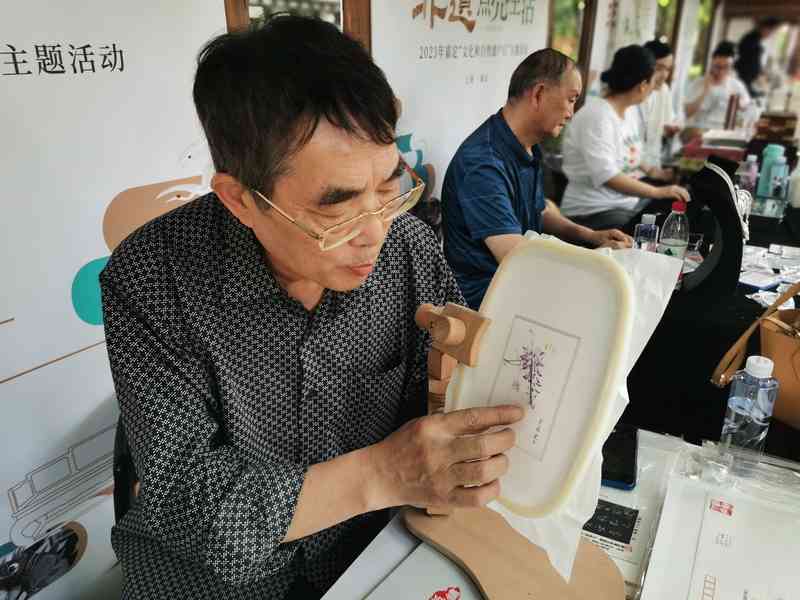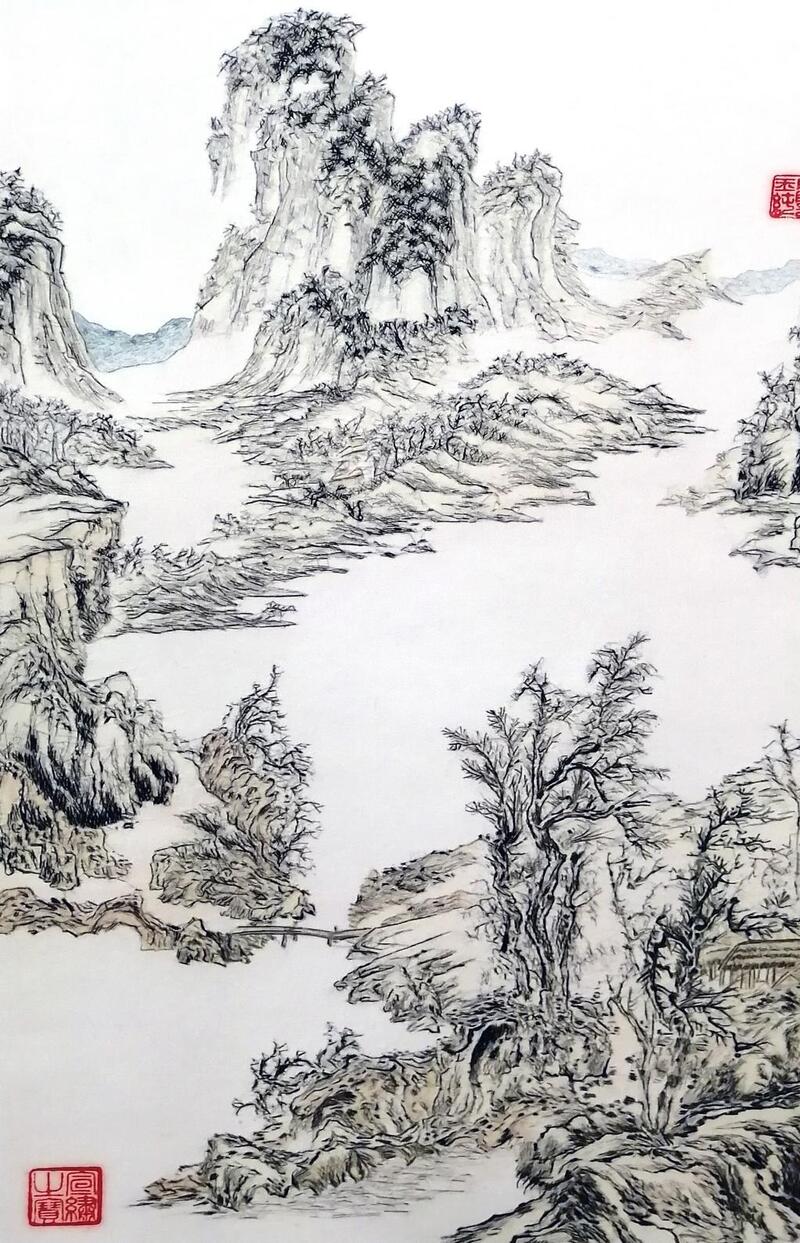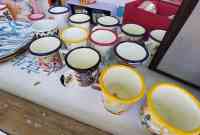How can intangible cultural heritage make a comeback?, Handmade embroidery originating from family ancestral halls and cultural heritage of enamel factories closed in the early 21st century | Craftsmanship | Embroidery
June 10th is World Cultural and Natural Heritage Day. In Guyi Park, the first "Intangible Cultural Heritage Theme Park" in Shanghai, dozens of intangible cultural heritages such as Jiangnan boudoir paintings, Ma Lu bamboo weaving techniques, medicinal patchwork printing and dyeing techniques, Dong Xiao making techniques, and Su embroidery are arranged in interactive booths.
The immersive Chinese style market held by Guyi Garden and Jiading District Cultural and Tourism Bureau has awakened the enthusiasm of many citizens for traditional folk skills and culture.
The reason behind this is not the form of showcasing intangible cultural heritage, but whether intangible cultural heritage itself has strong vitality and attraction. On site, numerous inheritors shared their experiences in protecting and inheriting intangible cultural heritage.
innovate
From a distance, it looks like a traditional Chinese painting of mountains and rivers, while up close, each stroke and ink turns out to be a thread of embroidery. This is Gu Jia's paper embroidery, an intangible cultural heritage of Jiading District. It is currently the only embroidery technique in China that can be applied on paper materials.

Gu Family Paper Embroidery was founded by Gu Jiubao and his wife Xu, who moved to Situ Township in Gaoyou, Yangzhou. It is used to create handmade embroidery products in the form of ancestral statues and family governance instructions in ancestral halls.
From written records to the present, Gu's paper embroidery has a history of more than 140 years. Since 2003, Gujia Paper Embroidery has been open to the outside world for apprenticeship. Today, more than 30 masters and apprentices are mainly distributed in Shanghai, Guangdong, and Jiangxi. There are also research institutes, workshops, and cultural dissemination companies established in Shanghai and Jiangxi.
"Some apprentices can earn a small income of several hundred thousand yuan per year with this skill, solving many pain points of intangible cultural heritage where 'skilled women cannot cook without rice'. Gu Yuchun, the ninth generation inheritor of Gu Family Paper Embroidery, said that in order to make intangible cultural heritage have lasting vitality, we cannot stick to conventions and must constantly innovate.".
The original base plate used in Gujia paper embroidery was a thick cardboard made by bonding double-layer toilet paper. It developed into a base plate made by bonding rice paper and gauze in the late Qing Dynasty and the Republic of China era, and was further innovated by the eighth and ninth generations of inheritors, who used only rice paper and directly embroidered on it.
"Brushes and ink can paint landscapes, and embroidery can also do it! My dream is to use embroidery to draw ink paintings." Gu Yuchun admitted that if we don't innovate, the audience of Gu's paper embroidery, which was originally used to serve family temples, will become increasingly narrow, and the outcome of no one's attention will be extinction. If this road can be paved, Gu Jia's paper embroidery works may be on par with calligraphy and painting, upgraded to works of art, and the future is vast.

The biggest challenge of this innovation lies in paper and thread.
After nearly a hundred experiments, Gu Yuchun collaborated with papermakers to produce embroidery specific rice paper. With the addition of cotton fibers and long fibers, this rice paper has sufficient toughness and thickness. When used as a base with pen and ink, there is not much difference from calligraphy and painting rice paper, and it can meet the special requirements of needle threading. Compared with the previous two generations of paper, it also has advantages such as being less prone to mold and resistant to storage.
As for the thread, traditional embroidery thread is too colorful and easy to "cut through" in ink painting. After research and development, Gu Yuchun has developed a unique matte silk thread, which has nearly 40 colors from black to gray and then to white, reflecting the changes in ink intensity, dryness, and wetness, achieving the embroidery thread hidden in the painting.
Gu Jia Paper Embroidery: "Mountains and Rivers Yu Hui Tu", provided by interviewees of huge traditional Chinese painting works
trend

Who would have thought that the enamel that was popular in Shanghai in the 1970s and 1980s would once again be at its end in the early 21st century.
I entered the factory in 1973, when enamel products were at their peak. I didn't expect the factory to collapse before I even retired. At that time, I felt like the sky was falling. Xie Dangwei, the inheritor of the Eight Fen Garden enamel making skills, was the last director of Jiuxin Enamel Factory. In September 2002, Jiuxin Enamel Factory ceased production, and since then, there have been no enamel factories in Shanghai.
Witnessing the rise and fall of Shanghai's enamel industry, Xie Dangwei was deeply saddened and said, "Do you know that in 1916, China's first enamel factory was born in Shanghai, and since then, Shanghai has become the cradle of China's enamel industry."
To this day, Xie Dangwei still remembers the five best-selling "three piece sets" at Jiuxin Enamel Factory: a pair of pots, a pair of cups, and a pair of high footed spittoons. There are five styles: colorful, beautiful and full moon, hibiscus mandarin ducks, bamboo peonies, and money peonies. The master of traditional Chinese painting designed them for a price of 122 yuan, which is equivalent to three or four months of salary at that time. They are still in high demand with a marriage certificate, and are known as the "Five Golden Flowers".
After the mid-1990s, due to the adjustment of the national industrial structure and issues such as high energy consumption, enamel factories in major cities in China were successively shut down.

Xie Dangwei said that there is actually another reason why enamel daily necessities cannot sell cheaper and lighter plastic products. "This taught me a lesson that in order for enamel to revive, it must keep up with the times and meet the taste of mainstream consumer groups, otherwise it will eventually become a tear of the times."
In fact, intangible cultural heritage can also be very fashionable. Enamel itself is a very suitable carrier for carrying other cultures. Compared to materials such as ceramics, it also has the advantage of higher production efficiency, which is in line with the psychology of consumers who pursue personalization but do not want to wait too long.
Eight years ago, Xie Dangwei and his son who returned from studying abroad began exploring the new trend of enamel. They improved the design of enamel products, "hidden" the bracket print left by traditional technology at the bottom of the cup under the curling edge of the cup mouth, made the cup mouth wider, and also borrowed traditional arts such as New Year pictures and Paper Cuttings, so that beautiful and cultural pictures and texts can climb all over the cup body... Soon, enamel cups more in line with the aesthetics of modern young people were sought after, and they had a new brand name - "Jiushen".
"A newlywed couple ordered 800 pairs of enamel cups, painted with their cartoon characters and handwritten calligraphy, which moved me deeply." Xie Dangwei said, as if seeing the shadow of the previous "five golden flowers". It turned out that the demand for enamel as a wedding decoration has always been there, but it needs to be expressed in a way that conforms to the aesthetic of the times.
To make the future of enamel go further, we cannot blindly cater to the mainstream aesthetic of the present, but also need to constantly discover and create new value. Xie Dangwei stated that the "Jiushen" team is constantly exploring folk customs and fashion culture, making enamel a carrier that leads new trends.





